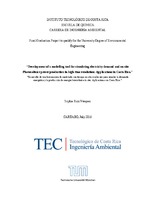Desarrollo de una herramienta de modelado con tiempo en alta resolución para simular la demanda energética y la producción de energía fotovoltaica in situ: Aplicaciones en Costa Rica.
Abstract
Nowadays strategies towards more energy-efficient systems imply the integration and
application of urban energy analysis tools, in order to support the sustainable energy
systems. In intermittent solar power systems, the tools which couple energy modelling to
assess the matching energy indexes require especial research into the comprehensive
analysis between the demand and the production involving minimal source of error.
A significant source of error is attributed to the coarser time step resolutions used in the
simulations; consequently, this also affects the matching indexes results. Solar energy
production and domestic energy demand minute resolution models were created in order to
identify the impact of time-step.
The generated PV on-site production model was developed with data from the research
group Energy Efficient and Smart Cities (EESC) of the Technische Universität München.
Relevant data needed for the model, such as irradiance and incident global radiation, were
obtained using the software Meteonorm. The statistic computations of the high-resolution
model of domestic electricity demand developed by the Centre for Renewable Energy
Systems Technology of Loughborough University were used and modified in order to
create the demand model that adequately represents energy demand in Costa Rica.
The matching error was more noticeable in partially cloudy sky conditions; the error was
39,18% for the month in study. In one case scenario, it was shown that daily resolution
profiles conduce to the assumption that all the PV power produced is used to cover the
house demand, although the 1-minute resolution results indicate that only 39% could be
used with this purpose. Overall, it was found that the coarser resolutions average the
existing demand and generation profiles spikes into much more continuous and flatter
profiles, leading to an inaccurate representation of the general demand profile.
Description
Proyecto de Graduación (Licenciatura en Ingeniería Ambiental) Instituto Tecnológico de Costa Rica, Escuela de Química, 2016.


